1. Ng YL, Mann V, Gulabivala K. A prospective study of the factors affecting outcomes of non-surgical root canal treatment: part 2: tooth survival. Int Endod J. 2011; 44:610–625. PMID:
21366627.

2. Gillen BM, Looney SW, Gu LS, Loushine BA, Weller RN, Loushine RJ, Pashley DH, Tay FR. Impact of the quality of coronal restoration versus the quality of root canal fillings on success of root canal treatment: a systematic review and meta-analysis. J Endod. 2011; 37:895–902. PMID:
21689541.

3. Ray HA, Trope M. Periapical status of endodontically treated teeth in relation to the technical quality of the root filling and the coronal restoration. Int Endod J. 1995; 28:12–18. PMID:
7642323.

4. Sorensen JA, Martinoff JT. Intracoronal reinforcement and coronal coverage: a study of endodontically treated teeth. J Prosthet Dent. 1984; 51:780–784. PMID:
6376780.

5. Suksaphar W, Banomyong D, Jirathanyanatt T, Ngoenwiwatkul Y. Survival rates against fracture of endodontically treated posterior teeth restored with full-coverage crowns or resin composite restorations: a systematic review. Restor Dent Endod. 2017; 42:157–167. PMID:
28808632.

6. Fransson H, Dawson VS, Frisk F, Bjørndal L, EndoReCo O, Kvist T. Survival of root-filled teeth in the Swedish adult population. J Endod. 2016; 42:216–220. PMID:
26813417.

7. Aquilino SA, Caplan DJ. Relationship between crown placement and the survival of endodontically treated teeth. J Prosthet Dent. 2002; 87:256–263. PMID:
11941351.

8. Pratt I, Aminoshariae A, Montagnese TA, Williams KA, Khalighinejad N, Mickel A. Eight-year retrospective study of the critical time lapse between root canal completion and crown placement: its influence on the survival of endodontically treated teeth. J Endod. 2016; 42:1598–1603. PMID:
27625148.

9. Sedgley CM, Messer HH. Are endodontically treated teeth more brittle? J Endod. 1992; 18:332–335. PMID:
1402595.

10. Faria ACL, Rodrigues RCS, de Almeida Antunes RP, de Mattos Mda G, Ribeiro RF. Endodontically treated teeth: characteristics and considerations to restore them. J Prosthodont Res. 2011; 55:69–74. PMID:
20709618.

11. Panitvisai P, Messer HH. Cuspal deflection in molars in relation to endodontic and restorative procedures. J Endod. 1995; 21:57–61. PMID:
7714437.

12. Reeh ES, Douglas WH, Messer HH. Stiffness of endodontically-treated teeth related to restoration technique. J Dent Res. 1989; 68:1540–1544. PMID:
2584522.

13. Jirathanyanatt T, Suksaphar W, Banomyong D, Ngoenwiwatkul Y. Endodontically treated posterior teeth restored with or without crown restorations: a 5-year retrospective study of survival rates from fracture. J Investig Clin Dent. 2019; 10:e12426.

14. Dammaschke T, Nykiel K, Sagheri D, Schäfer E. Influence of coronal restorations on the fracture resistance of root canal-treated premolar and molar teeth: a retrospective study. Aust Endod J. 2013; 39:48–56. PMID:
23890259.

15. Corsentino G, Pedullà E, Castelli L, Liguori M, Spicciarelli V, Martignoni M, Ferrari M, Grandini S. Influence of access cavity preparation and remaining tooth substance on fracture strength of endodontically treated teeth. J Endod. 2018; 44:1416–1421. PMID:
30049468.

16. Linn J, Messer HH. Effect of restorative procedures on the strength of endodontically treated molars. J Endod. 1994; 20:479–485. PMID:
7714419.

17. Mannocci F, Bertelli E, Sherriff M, Watson TF, Ford TR. Three-year clinical comparison of survival of endodontically treated teeth restored with either full cast coverage or with direct composite restoration. J Prosthet Dent. 2002; 88:297–301. PMID:
12426500.

18. Suksaphar W, Banomyong D, Jirathanyanatt T, Ngoenwiwatkul Y. Survival rates from fracture of endodontically treated premolars restored with full-coverage crowns or direct resin composite restorations: a retrospective study. J Endod. 2018; 44:233–238. PMID:
29208401.

19. Nagasiri R, Chitmongkolsuk S. Long-term survival of endodontically treated molars without crown coverage: a retrospective cohort study. J Prosthet Dent. 2005; 93:164–170. PMID:
15674228.

20. Skupien JA, Cenci MS, Opdam NJ, Kreulen CM, Huysmans MC, Pereira-Cenci T. Crown vs. composite for post-retained restorations: a randomized clinical trial. J Dent. 2016; 48:34–39. PMID:
26976553.

21. Kumagai H, Suzuki T, Hamada T, Sondang P, Fujitani M, Nikawa H. Occlusal force distribution on the dental arch during various levels of clenching. J Oral Rehabil. 1999; 26:932–935. PMID:
10620156.

22. Ng YL, Mann V, Gulabivala K. Tooth survival following non-surgical root canal treatment: a systematic review of the literature. Int Endod J. 2010; 43:171–189. PMID:
20158529.

23. Chan CP, Lin CP, Tseng SC, Jeng JH. Vertical root fracture in endodontically versus nonendodontically treated teeth: a survey of 315 cases in Chinese patients. Oral Surg Oral Med Oral Pathol Oral Radiol Endod. 1999; 87:504–507. PMID:
10225635.

24. Lynch CD, McConnell RJ. The cracked tooth syndrome. J Can Dent Assoc. 2002; 68:470–475. PMID:
12323102.
25. Lubisich EB, Hilton TJ, Ferracane J. Northwest Precedent. Cracked teeth: a review of the literature. J Esthet Restor Dent. 2010; 22:158–167. PMID:
20590967.

26. Hiatt WH. Incomplete crown-root fracture in pulpal-periodontal disease. J Periodontol. 1973; 44:369–379. PMID:
4513616.

27. Caplan DJ, Kolker J, Rivera EM, Walton RE. Relationship between number of proximal contacts and survival of root canal treated teeth. Int Endod J. 2002; 35:193–199. PMID:
11843976.

28. Lee AH, Cheung GS, Wong MC. Long-term outcome of primary non-surgical root canal treatment. Clin Oral Investig. 2012; 16:1607–1617.

29. Schwartz RS, Robbins JW. Post placement and restoration of endodontically treated teeth: a literature review. J Endod. 2004; 30:289–301. PMID:
15107639.

30. Scotti N, Coero Borga FA, Alovisi M, Rota R, Pasqualini D, Berutti E. Is fracture resistance of endodontically treated mandibular molars restored with indirect onlay composite restorations influenced by fibre post insertion? J Dent. 2012; 40:814–820. PMID:
22743344.

31. Salameh Z, Sorrentino R, Papacchini F, Ounsi HF, Tashkandi E, Goracci C, Ferrari M. Fracture resistance and failure patterns of endodontically treated mandibular molars restored using resin composite with or without translucent glass fiber posts. J Endod. 2006; 32:752–755. PMID:
16861075.

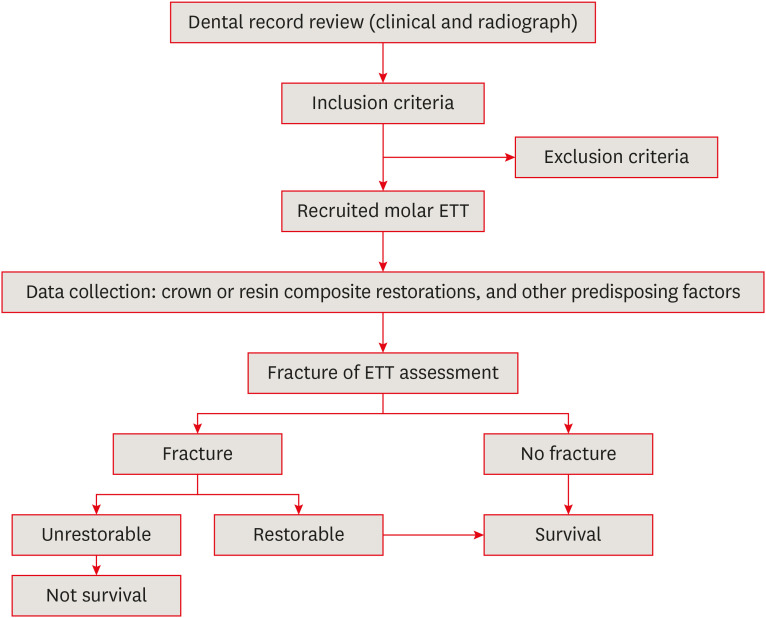
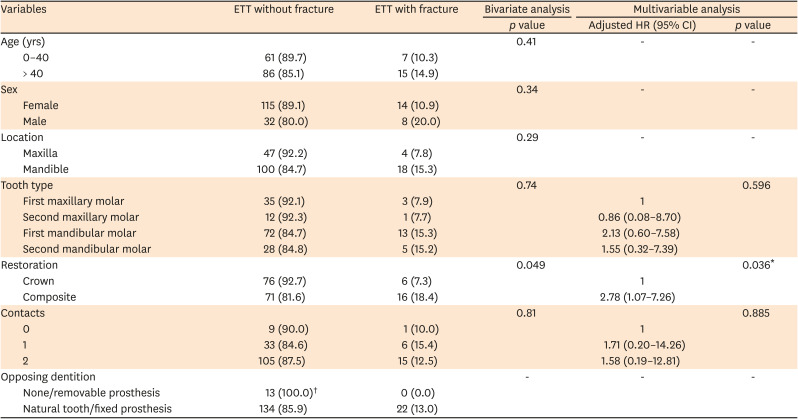
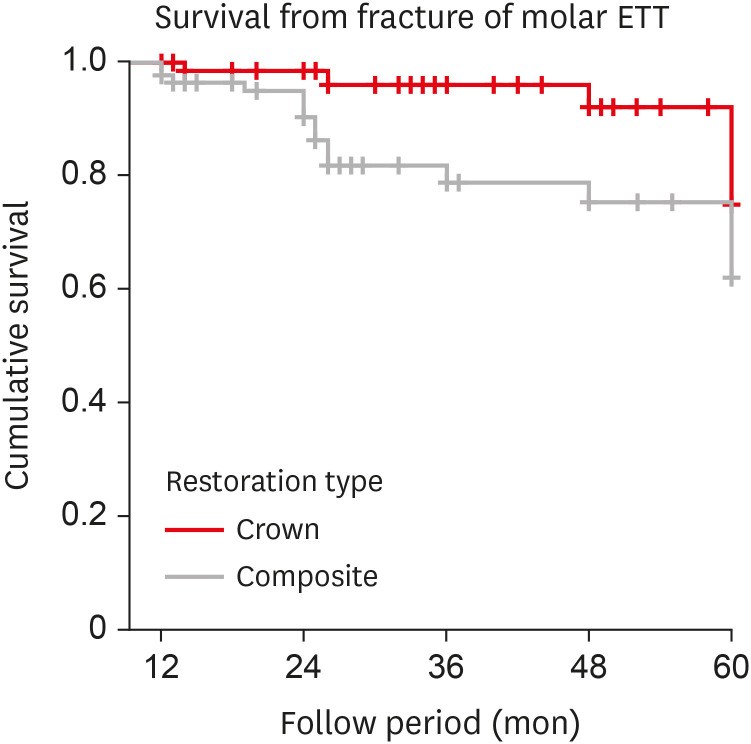

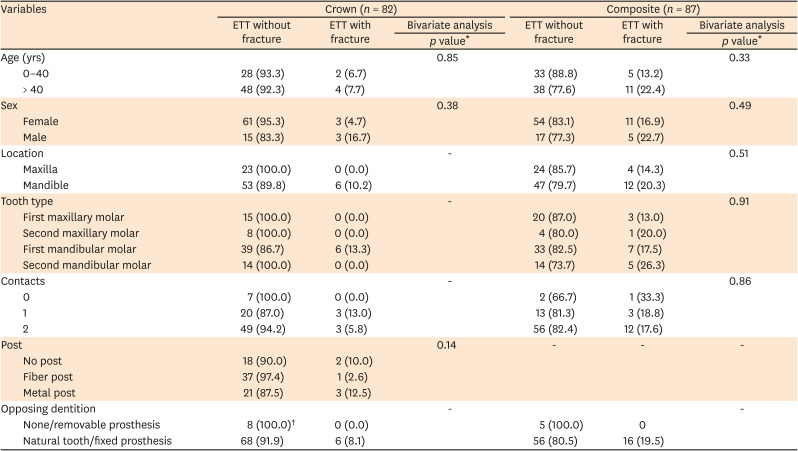

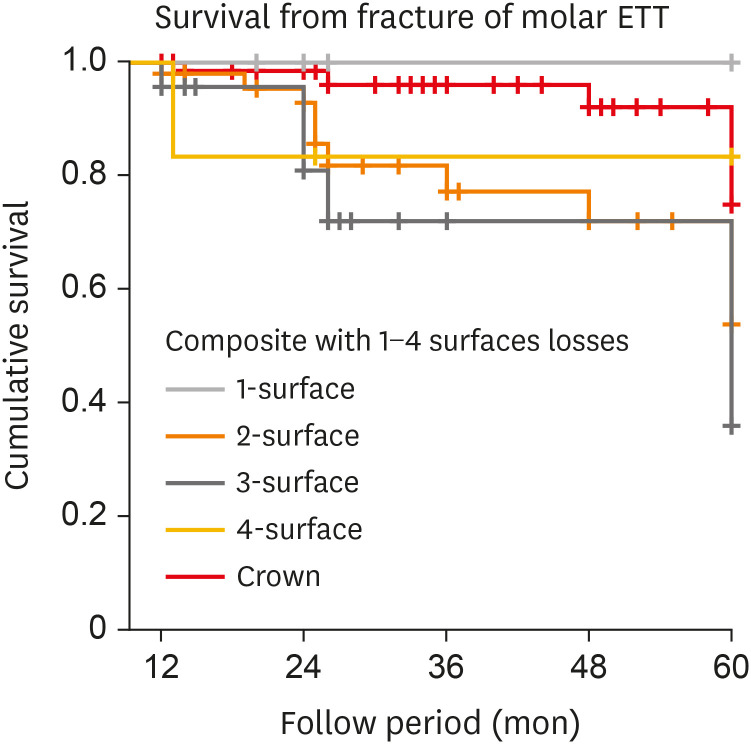




 PDF
PDF Citation
Citation Print
Print



 XML Download
XML Download